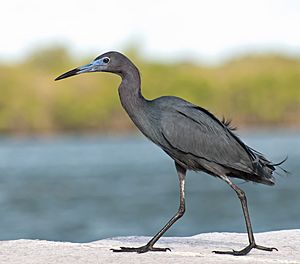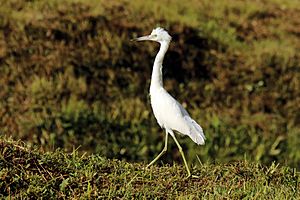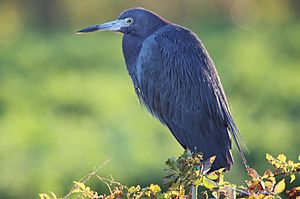Little blue heron facts for kids
Quick facts for kids Little blue heron |
|
|---|---|
 |
|
| Conservation status | |
| Scientific classification | |
| Genus: |
Egretta
|
| Species: |
caerulea
|
 |
|
| Distribution of Egretta caerulea: breeding non-breeding year-round | |
| Synonyms | |
|
Ardea caerulea Linnaeus, 1758 |
|
The little blue heron (Egretta caerulea) is a small bird from the heron family. It's known for its beautiful blue-grey feathers.
Contents
Where Do Little Blue Herons Live?
Little blue herons live in many places. They are found from the Gulf states in the U.S. all the way south. Their home range includes Central America, the Caribbean, and even Peru and Uruguay.
Most of these herons stay in the same area all year. However, some herons that live further north will migrate south for the winter. They might fly to the southeastern U.S. or even further. After breeding season, some young birds travel north. They can go as far as the Canada–US border!
What Do Little Blue Herons Look Like?

Little blue herons are medium-sized birds. They are usually about 64 to 76 centimeters (25 to 30 inches) long. Their wings can spread up to 102 centimeters (40 inches) wide. An adult heron weighs around 325 grams (11.5 ounces).
They have long legs and a long, pointed bill. The bill is usually pale blue or greyish with a darker tip.
Adult Herons
Adult herons have special feathers during breeding season. Their body is blue-grey. Their head and neck are a pretty purplish color. They also have long, flowing blue feathers called plumes. Their legs and feet are dark blue or greenish. Both male and female herons look similar.
When they are not breeding, their head and neck are a darker blue. Their legs are also a bit paler.
Young Herons
Young little blue herons look very different! For their first year, they are completely white. The only dark parts are the tips of their wings. Their legs are a dull greenish color.
In their first spring or summer, they slowly change. They start to get the darker feathers of the adults.
Similar Birds
The little blue heron looks a bit like the Reddish Egret. But the Reddish Egret is much larger and has a bigger bill. Young little blue herons can also look like young Snowy Egrets because both are white.
Life of a Little Blue Heron
Little blue herons like to live in wet places. They prefer freshwater swamps and lagoons in the southern areas. On islands, they live in thick bushes near the coast. They also nest in tropical swamps with mangrove trees. You can find them in wetlands like bogs and salt marshes too.
Nesting and Eggs
These herons build their nests in groups called colonies. They often share these colonies with other types of herons. Their nests are usually platforms made of sticks. They build them in trees or shrubs.
A female heron will lay three to seven light blue eggs.
What Do They Eat?
Little blue herons hunt for food in shallow water. They walk slowly and carefully, sometimes even running. They eat many different things! Their diet includes fish, frogs, crustaceans (like crabs), small rodents, and insects. They actually eat more insects than bigger herons do.
Adult herons usually hunt alone. But young herons often feed in groups.
Mixing with Other Birds
Young white little blue herons often hang out with snowy egrets. Snowy egrets are more accepting of these young white herons than they are of adult little blue herons.
When young herons are with snowy egrets, they actually catch more fish! Being in a flock of white herons also helps protect them from predators. This might be why they stay white for their first year of life.
- Little blue heron species account at Neotropical Birds (Cornell Lab of Ornithology)
Images for kids
See also
 In Spanish: Garceta azul para niños
In Spanish: Garceta azul para niños




